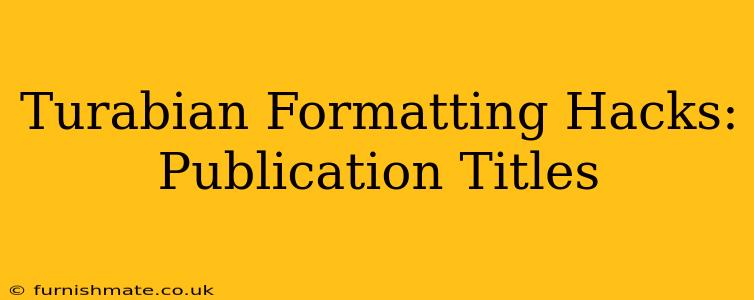Turabian style, a widely used citation format, particularly in the humanities, can sometimes feel tricky, especially when it comes to formatting publication titles. This guide provides helpful hacks and clarifies common areas of confusion to help you master the art of correctly citing publication titles in your Turabian papers. We'll cover both books and articles, addressing common questions and offering practical examples.
What's the Difference Between Titles of Books and Articles in Turabian?
This is a fundamental distinction. In Turabian, book titles are italicized, while article titles are enclosed in quotation marks. This simple rule helps readers quickly differentiate between the two types of publications.
Example:
- The Lord of the Rings (Book Title - italicized)
- "The One Ring to Rule Them All" (Article Title - quotation marks)
How to Format Journal Titles in Turabian?
Journal titles, like book titles, are italicized in Turabian. This is crucial for proper formatting and ensures consistency across your bibliography.
Example:
- The Journal of American History
How Do I Cite a Chapter in a Book Using Turabian?
When citing a chapter within a larger edited book, you'll use quotation marks for the chapter title and italics for the book title. Remember to also include the editor(s) name(s) and page numbers.
Example:
"The Impact of the Printing Press," in Renaissance Innovations, ed. John Smith (New York: Publisher, 2023), 123-145.
Do I Need to Italicize Subtitles in Turabian?
Yes, subtitles are included as part of the main title and should follow the same formatting rules. If the main title is italicized (like a book title), the subtitle should also be italicized. If the main title is in quotation marks (like an article title), the subtitle should also be in quotation marks.
Example:
- The History of the Roman Empire: A New Perspective
- "The Impact of the Printing Press: A Revolution in Communication"
What About Titles in Different Languages?
Titles in languages other than English should retain their original formatting and punctuation. You do not need to alter the title itself to fit English conventions. However, you should still italicize book titles and use quotation marks for article titles, regardless of the original language.
Example:
- La Comédie humaine (French book title - italicized)
- "Das Kapital" (German article title - quotation marks)
How Should I Handle Titles Within Titles?
When a title contains another title within it (e.g., an article title within a book title), maintain the established formatting. Use italics for book titles, and quotation marks for article or chapter titles within the larger work.
Example:
"The Influence of 'Hamlet' on Modern Literature" (Book title containing an article title)
What if a Title is Very Long?
For exceptionally long titles, you may shorten them in your in-text citation for brevity, but always use the full title in your bibliography. Use ellipses (...) to indicate omissions within the title. However, avoid shortening titles in a way that changes the meaning.
Example:
In-text citation: (Smith, Long Title of Book…, 15) Bibliography: (Smith, John. A Very Long Title Indeed: Subtlety and Nuance in Nineteenth Century English Literature. New York: Publisher, 2023.)
Using Turabian Formatting Software to Streamline the Process
While understanding the rules is crucial, using citation management software like Zotero or Mendeley can significantly simplify the process. These tools automatically format citations according to Turabian style, minimizing the risk of errors.
By following these Turabian formatting hacks and paying close attention to the details, you can confidently cite publication titles and enhance the credibility and professionalism of your academic work. Remember consistency is key!

